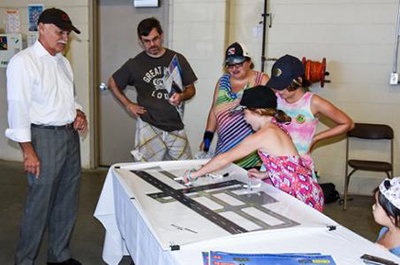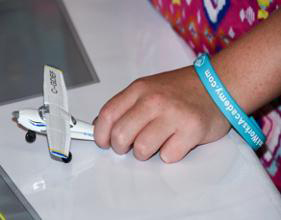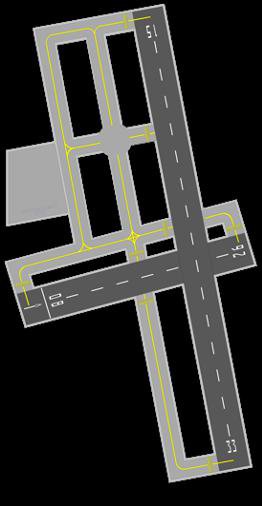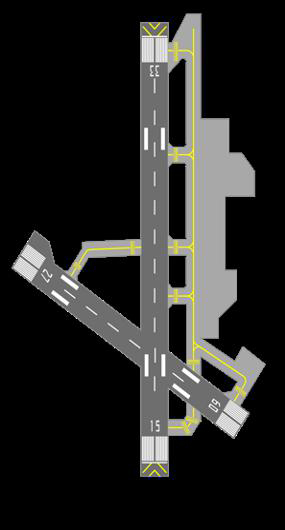Meet My Airport
By Jim Walker
November 2016
“Do you know how to fly a plane?”
“No.”
“You don’t? Would you like to?”
“Sure!”
That’s the response I always get. Kids and adults are so eager to fly. There’s something magic about being up there, even if it’s just imaginary. I am the curriculum designer at AviatPro. I am both a pilot and a trained teacher with about 35,000 hours teacher-in-command experience, some of it hard-won.

Photos by Gus Air
The AviatPro short program I do (about 10 minutes) gets kids and adults doing what pilots do all the time — move aircraft to a runway, take off and then have way more fun than they deserve … but you don’t have to be a kid to find this useful.
I designed a unique roll-out airport diagram that has taxiways and runways marked just like they are in real life. Wide runways, yellow taxiway centre lines, and a displaced threshold are a few of the features that make the instruction real.
The “pilots” move durable model aircraft to various locations once they’ve been instructed how to. After a few moments they’re turning final and landing on the active runway.
The airport diagram and model aircraft are what I use at Young Eagles rallies, Girls Take Flight adventures, and other events where the goal is to introduce people to flying. This is the short program.

Easy-to-handle models
I create the airport layouts and then have them printed. I have about 20 laminated copies of the Brampton airport available at cost, plus a small margin. Because the print runs are very small, the price is $70.95 Canadian each, plus shipping and handling. One can achieve all the “Meet My Airport” objectives using the Brampton airport diagram. The name “Brampton” does not appear on the vinyls, so they can be used as a generic airport. They would be great for flight schools too.

Write-on, roll-out airport, 30 inches x 48 inches, Brampton, Ontario (CNC3)
All that classroom experience and about 650 hours in aircraft have been synthesized into another longer program. This one takes about one and a half hours to teach aspiring pilots how to move aircraft around an airport. Airport layout is taught, how to taxi, and how to manoeuvre in a left-hand circuit.
Unambiguous communication between pilots and air traffic control is essential. The phonetic alphabet is introduced and mastered in the longer program. Position reports in the circuit keep everybody separated and headed in the same direction. In fact, everything is mastered.
Knowing what to say and how to say it can be a frustrating experience. However, it needn’t be if the teaching is effective. A great teacher demonstrates the skills and then presents lots of opportunities to master those skills. I am not a fan of the YOYO teaching method: You’re on your own.
The longer program is designed for individuals and groups who want more detail. Air Cadets comes to mind, or those studying aviation in a school setting, or perhaps EAA chapters discussing local airspace issues.
Several different airport diagrams are available. Setting up two airports provides lots of opportunities to practice navigation and radio skills inexpensively.
A propeller’s not spinning, weather isn’t a factor, and there’s no rush.
Effective teaching uses The Goldilocks Principle: Not too fast, not too slow, just right.
Direct instruction teaching techniques are the foundation of everything AviatPro designs. The teacher reads a script that has been field-tested four times. Two groups of 19-25 year olds were interesting to work with, but the most fun I had with this testing was with two separate groups of 45-65 year olds. At times they were an animated group who really wanted to have fun. In situations like that, my classroom management skills helped keep the program running smoothly, everybody learning, and the skills mastered in a fun atmosphere. Thirty years of teaching will do that.

Write-on, roll-out airport, 30 inches x 48 inches, London, Ontario (CYXU)
If an EAA chapter or other organization or school wants to have an airport diagram for their airport, I can certainly do that. It takes me about two days of detailed work to get the layout ready for printing. That layout process costs $525 — less than what I have to pay a painter to make my bathroom walls a different colour.
The printing firm uses a wide-format printer and adds write-on laminating. I’ve found that a single-run, laminated airport diagram costs about $125. The total investment for a custom airport diagram, then, is $650. Of course, more copies means the unit cost goes down quickly.
I’ve used my demonstration airport diagram for two years now, and it’s still in very good condition.
You might also want some advice on how to design an effective aviation program.
I can help!
If you are interested in getting one of these vinyls, maybe having one made of your own airport, or if you want more information about Meet My Airport, please contact me, Jim Walker, at AviatPro Aviation Teaching Systems. Phone 647-381-8765 during business hours Eastern time, or e-mail aviatpro@gmail.com
